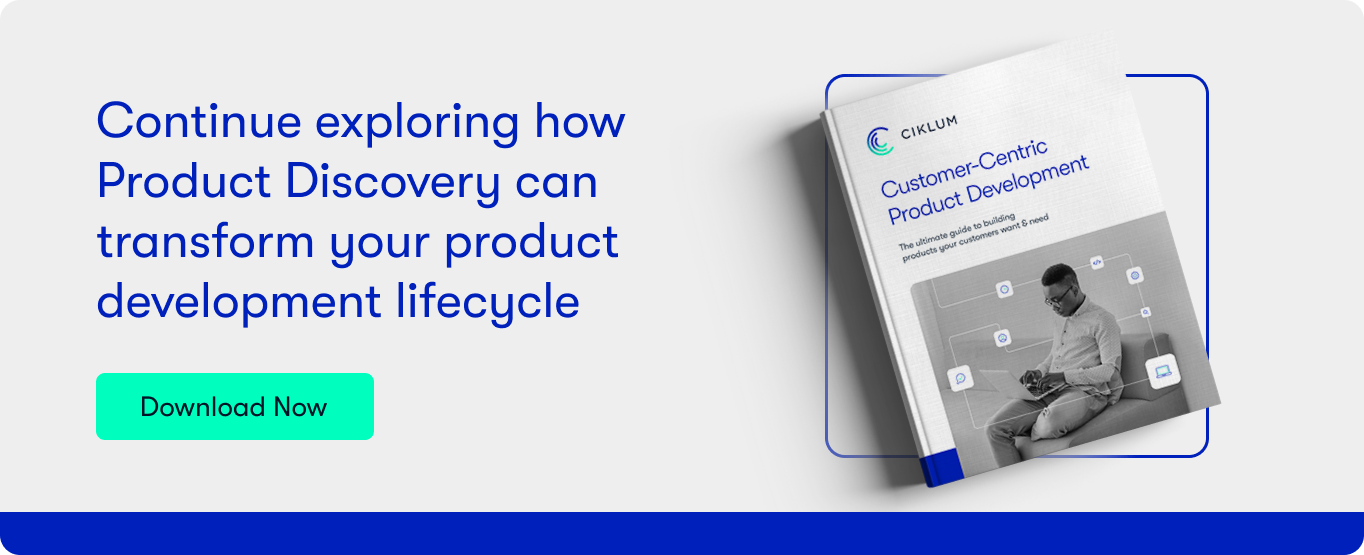In today's fast-paced tech landscape, the pressure to constantly iterate and be the first to market is immense. But it’s not uncommon for cutting-edge products to still fall short of commercial success. In fact, according to Harvard Business School professor Clayton Christensen 95% of new products end up failing.
This can often be attributed to product teams rushing into development without gaining a deep understanding of what their customers truly need. Product Discovery mitigates these risks.
What is Product Discovery?
Product Discovery is a strategic approach that empowers businesses to integrate valuable customer insights into every decision made throughout the product development process.
By conducting thorough research, gathering user feedback, and analyzing market trends, product teams can gain a holistic understanding of customer needs and preferences.
This enables them to build products that are not only innovative but also aligned with customer expectations, increasing the chances of commercial success.
The Product Discovery Process Explained
It's important to recognize that there is no one-size-fits-all methodology for implementing Product Discovery in your product roadmap. Product discovery teams can choose to use a combination of various product discovery techniques to learn more about their customers. The best methodology for your project will depend on your product type and the industry your business is in.
That said, regardless of the specific methodology you choose, your Product Discovery process will likely still cover these four fundamental steps:
1. Understand the underlying needs of your customers
The first step of Product Discovery is understanding your customer needs before deciding on a specific pain point to address.
User-centric exploration:
Open yourself to learning about customer pain points that may not have been considered before. This is your chance to also test your existing assumptions about what your customers actually want.
Taking the time to thoroughly investigate, empathize and speak with your customers is key. Rushing your user research can hinder the process and lead to misinformed decisions down the line.
Exploration of techniques:
During this stage, selecting the right research methodology is essential to obtain an accurate and reliable assessment of your customer needs.
Use this opportunity to explore various product discovery techniques such as customer interviews, competitor analysis, surveys, customer journey mapping and focus groups. Depending on the industry of your business, some research methods will be more suitable than others.
For example, in the retail industry, surveys and focus groups will be your best option for gathering data from a large sample size. Meanwhile, customer interviews can be a great source of in-depth qualitative data for companies in the enterprise software industry.
Market research:
Remember to also allocate sufficient time to conduct comprehensive market research. This will allow your team to learn about the unique considerations for your chosen market.
For instance, if your business is planning to enter the Fintech industry your team will need to consider the financial regulations that need to be followed.
At the same time, your team should also analyze the competitive landscape and identify existing gaps in the market. This will help your team formulate ideas of how to differentiate your product later on in development.
2. Define the customer problem at hand
After gathering sufficient user feedback and developing a comprehensive understanding of your customer's problems, your product discovery team can move on to the next step.
Pattern recognition:
By analyzing the data, specific recurring key problems should start to become more apparent in your customer responses. These valuable insights will enable your product discovery team to formulate a hypothesis that encapsulates the central issues that your customers are experiencing.
Pain point validation:
At this crucial juncture, your team should reach out to users again to validate the identified pain points and determine how important they are. This validation process ensures that your team's efforts are focused on the most impactful and beneficial areas.
Hypothesis crafting:
Crafting a concise and well-defined hypothesis is crucial as it provides a clear product vision that can be effectively communicated to both management and engineering teams.
It is important to ensure that this hypothesis is aligned with both your business objectives and customer needs. It will serve as a guiding principle for your product discovery team's decision-making process moving forward.

3. Develop a solid product concept
Now that a customer-centric hypothesis has been clearly established, your product discovery team can start shifting their attention to developing a solution.
Creative ideation:
Leveraging the knowledge and insights gained so far, your product design team can begin planning ideation sessions to explore and propose potential product concepts.
These product concepts should not only describe the product’s features but also provide a clear explanation of how they are tied to meeting the needs of your customers and improving the user experience.
Product idea evaluation:
This is a good moment to actively involve key members of the engineering team in the Product Discovery process. By tapping into their valuable input, they can help assess the feasibility risks of the product concepts. This allows your design team to scrap flawed ideas or make any necessary modifications early on.
Feature prioritization:
Your product discovery team should start to narrow down the most important features for the planned product based on factors such as user value, business value, and feasibility. This ensures that resources and effort are used optimally on key value-adding features.
4. Test and validate the product
The final phase of product discovery is where product ideas start coming to life through prototyping and testing.
Building a prototype:
When starting the prototyping journey, it is often beneficial to begin with low-fidelity prototypes. These early-stage prototypes can be as simple as sketches or wireframes that capture the basic functionality and layout of your product. This allows you to focus on the core features without getting caught up in unnecessary details.
As you continue to refine and iterate on your prototype, you can gradually move on to middle-fidelity prototypes. These prototypes provide a more polished representation of your product, incorporating more details and interactions. They help you better visualize how your product will look and feel.
Finally, as you approach the final stages of prototyping, high-fidelity prototypes come into play. These prototypes closely resemble the final product in terms of aesthetics and interactivity and enable you to showcase the full potential of your product to stakeholders and users alike.
Iterative user validation:
At each round of prototyping, it is important to test and validate each prototype. Ultimately, the best way to determine if you are on the right track with your product development is to get feedback from actual users. This will help your team to identify potential design flaws and gauge what the user experience is like.
Conclusion
In summary, the four main stages of Product Discovery are integral to the successful development of any product. They provide a structured roadmap that allows teams to continuously incorporate customer insights at each stage of product development.
To ensure the success of your product, you may want to consider how the right partner who is familiar with the complexities of Product Discovery can help you further streamline the process. This is where an experienced partner like Ciklum is ready to support your most ambitious projects.
As a prominent custom product engineering company, we collaborate with organizations of all sizes to overcome intricate business obstacles with our custom product engineering, automation, and data & analytics solutions.
Get in touch with us today to discuss how we can help you create game-changing products that are certain to impress your customers.

































